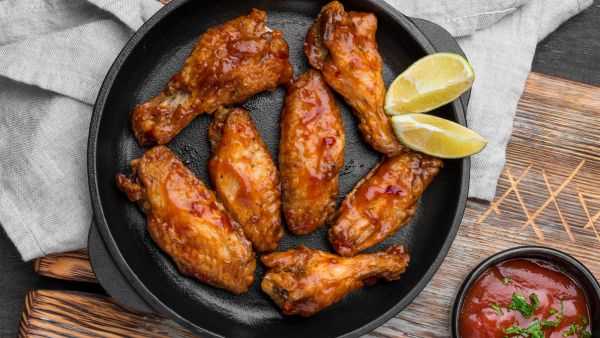



Bird flu, also known as avian influenza, is a viral infection that primarily affects birds. In rare cases, it can also spread to humans. The transmission of bird flu to humans usually occurs through direct contact with infected birds or their secretions.
One of the common misconceptions about bird flu is that it can be contracted by consuming cooked chicken. However, this is not true. The virus responsible for bird flu, such as the H5N1 strain, is not easily transmitted through cooked poultry.
Cooking chicken at temperatures above 165°F (74°C) kills most bacteria and viruses, including the bird flu virus. Therefore, when poultry is properly cooked, the risk of contracting bird flu is extremely low.
However, it is important to note that the handling and preparation of raw chicken should be done with caution. It is always recommended to practice good hygiene, such as washing hands thoroughly after handling raw poultry, to minimize any potential risk of infection.
In conclusion, while bird flu can be a serious disease for birds and occasionally humans, the risk of getting infected from eating properly cooked chicken is very low. By following proper food safety guidelines, you can enjoy poultry products without worrying about bird flu.
What is Bird Flu?
Bird flu, also known as avian influenza, is a highly infectious viral disease that primarily affects birds. The virus can also be transmitted to humans, causing a range of flu-like symptoms, from mild to severe. In some cases, bird flu can even be fatal.
The virus spreads through the respiratory secretions of infected birds. It can be transmitted through direct contact with infected poultry or their feces, as well as through consumption of contaminated poultry products, such as raw or undercooked chicken.
The symptoms of bird flu in humans can include fever, cough, sore throat, muscle aches, and shortness of breath. In severe cases, it can lead to pneumonia and respiratory failure.
There are different strains of bird flu virus, with varying levels of severity and transmission. The H5N1 strain, for example, has caused several outbreaks in poultry and humans, resulting in significant economic losses and public health concerns.
Preventing bird flu involves measures such as proper hygiene, avoiding close contact with birds, and cooking poultry products thoroughly. Vaccines are also available for specific strains of bird flu.
If you suspect you have been exposed to bird flu or are experiencing flu-like symptoms after contact with birds, it is important to seek medical attention promptly. Early diagnosis and treatment can help minimize the severity of the infection.
Symptoms, Causes, and Risks
Bird flu, also known as avian influenza, is a viral infection that primarily affects birds. However, certain strains of bird flu viruses can also infect humans and cause illness. In most cases, people become infected with bird flu by handling infected birds or coming into contact with their droppings or secretions.
Symptoms
The symptoms of bird flu in humans can vary, ranging from mild to severe. Some common symptoms include:
- Fever
- Cough
- Sore throat
- Muscle aches
- Headache
- Shortness of breath
In severe cases, bird flu can lead to pneumonia, respiratory failure, and even death.
Causes and Risks
Bird flu viruses primarily circulate among birds, particularly wild birds. The viruses can be found in their saliva, nasal secretions, and feces. When humans come into direct contact with infected birds or their droppings, they can contract the virus. This can occur through handling infected birds, visiting live poultry markets, or being in close proximity to contaminated surfaces or materials.
There are several factors that can increase the risk of bird flu infection in humans. These include:
- Working or living in close proximity to live poultry
- Traveling to countries or regions where bird flu outbreaks have occurred in birds or humans
- Handling or consuming uncooked or undercooked poultry products contaminated with the virus
It is important to note that properly cooked chicken and poultry products pose a minimal risk of bird flu transmission to humans. Cooking chicken at a temperature of at least 165°F (74°C) kills the bird flu virus and other harmful bacteria.
How is Bird Flu Transmitted?

Bird flu, also known as avian influenza, is primarily transmitted through contact with infected birds. The virus is typically found in the saliva, nasal secretions, and feces of infected birds. Humans can become infected with bird flu by coming into close contact with infected birds or their droppings.
The most common way that bird flu is transmitted to humans is through the handling, slaughtering, or consumption of infected poultry, such as chickens or ducks. When poultry is not cooked to the appropriate temperature, the bird flu virus may survive and can potentially be transmitted to humans who consume the infected meat.
It’s important to note that properly cooked chicken or other poultry products are safe to eat and do not pose a risk of transmitting bird flu. Cooking poultry to an internal temperature of at least 165°F (74°C) kills the virus and reduces the risk of infection.
In rare cases, bird flu can also be transmitted from person to person. This typically occurs when there is close and prolonged contact with an infected individual, such as caring for a sick family member. However, person-to-person transmission of bird flu is very rare and the virus does not easily spread between humans.
To prevent the transmission of bird flu, it is important to practice good hygiene, such as washing hands thoroughly with soap and water after handling poultry or touching surfaces that may have come into contact with infected birds. It is also recommended to properly cook poultry products to ensure the virus is killed.
Understanding the Spread of the Virus

Avian influenza, commonly known as bird flu, is caused by the influenza type A viruses that primarily infect birds. While most strains of avian influenza do not infect humans, certain strains, such as the H5N1 and H7N9, have been known to cause severe illness and even death in humans.
It is important to understand how the virus spreads in order to prevent its transmission. The primary mode of transmission of bird flu is through direct contact with infected birds or their droppings. This can occur through activities such as handling infected poultry, visiting live bird markets, or being in close proximity to infected birds.
In some cases, the virus can also be spread indirectly through contact with contaminated surfaces such as cages, equipment, or clothing that have come into contact with infected birds. It is advisable to practice good hygiene, such as washing hands thoroughly with soap and water, to reduce the risk of contamination.
The consumption of properly cooked chicken or other poultry products is generally considered safe and does not pose a significant risk of contracting bird flu. Cooking at temperatures above 70°C (160°F) kills the virus and ensures its inactivation. It is important to handle and cook poultry products properly to avoid cross-contamination with any potential pathogens.
Surveillance and Control Measures
Monitoring and surveillance programs are implemented by authorities to detect and control the spread of bird flu. This involves regular testing of poultry farms, live bird markets, and wild bird populations to identify and contain any outbreaks.
In the event of an outbreak, control measures may include quarantine, culling and disposal of infected animals, as well as strict biosecurity protocols to prevent further transmission. These measures help to mitigate the spread of the virus and protect both human and animal health.
Conclusion
While bird flu can be a serious health concern, the risk of contracting the virus through the consumption of properly cooked chicken is minimal. Understanding the spread of the virus and practicing good hygiene measures can help reduce the risk of transmission. It is essential for individuals and authorities to remain vigilant and take appropriate measures to prevent and control the spread of bird flu.
Is Cooked Chicken Safe to Eat?
Many people wonder if they can contract bird flu, also known as avian influenza, from eating cooked chicken. The simple answer is no. When chicken is cooked to the recommended internal temperature of 165°F (74°C), any potential avian influenza virus present in the meat is killed, making it safe to eat.
Avian influenza is primarily transmitted through contact with infected birds, not through properly cooked poultry. It is important to remember that cooking chicken thoroughly is essential to kill any bacteria or viruses that may be present, including those that can cause foodborne illnesses like salmonella.
Cooking chicken at high temperatures not only destroys harmful bacteria and viruses, but it also ensures that the meat is juicy and flavorful. It is crucial to follow proper food safety practices, such as washing hands before and after handling raw chicken, preventing cross-contamination between raw and cooked foods, and storing cooked chicken at safe temperatures to avoid the risk of foodborne illnesses.
Additionally, it is worth mentioning that the chicken industry adheres to strict guidelines and regulations to prevent the spread of avian influenza. Producers take extensive measures to ensure the safety and quality of the chicken products available in the market.
In conclusion, properly cooked chicken is safe to eat and does not pose a risk of contracting bird flu or avian influenza. By practicing good food safety habits and cooking chicken to the recommended temperature each time, individuals can confidently enjoy delicious chicken dishes without worrying about potential health risks.
Questions and answers
Can you get bird flu from eating cooked chicken?
No, you cannot get bird flu from eating properly cooked chicken. Cooking chicken at a high temperature kills the bird flu virus.
What is bird flu?
Bird flu, or avian influenza, is a viral infection that primarily affects birds. It is caused by a strain of influenza A virus. Some strains of bird flu can be transmitted to humans, although this is rare.
Is it safe to eat chicken during a bird flu outbreak?
Yes, it is safe to eat chicken during a bird flu outbreak. The virus is killed by cooking at a high temperature, so as long as the chicken is cooked properly, there is no risk of getting infected.
What are the symptoms of bird flu in humans?
The symptoms of bird flu in humans can vary, but they can include fever, cough, sore throat, muscle aches, and shortness of breath. In severe cases, it can lead to respiratory distress, organ failure, and even death.
Can bird flu be transmitted from human to human?
While some strains of bird flu can be transmitted from birds to humans, the transmission of the virus from human to human is extremely rare. Most cases of human infection occur from contact with infected birds or contaminated environments.






